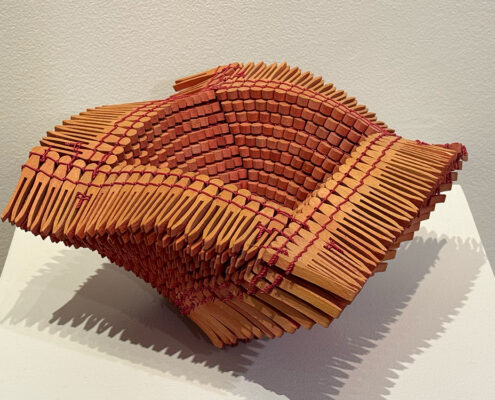
Karyl Sisson is drawn to common manufactured objects – clothespins, zippers, cloth tape measures and paper drinking straws. These undervalued materials serve as her inspiration, reminding her of her childhood. Her artistic practice embraces recycling and repurposing these everyday items, transforming them into sculptures and wall art through simple interlocking techniques found in basketry and needlework. The artwork, like the process that creates it, is laden with patterning and repetition, referencing themes of connection, containment and touch. Sisson finds inspiration in the beauty and simplicity of indigenous and animal architecture, organic growth, and patterns found both in nature and human constructs.
Return to 9 x 9: Contemporary Quilts & Containers HERE.
Faux Pot Series, 1997-2004. This work is both a play on ceramic forms and an investigation of patterning. These container forms are made by coiling old cloth tape measures until the desired diameter is attained. I push down the center and pull up the sides, a process similar to a potter throwing clay on a wheel. Once the shape is complete, I apply polymer to prevent the form, if pressed, from collapsing like an accordion. Since the tape measure is double-sided, the exposed edge will determine the interior and exterior patterning. The tape measures allude to quantity and value, but it’s the implications of the edge that interest me most.
Piece Work Series. Since the late 1980s I’ve worked with vintage paper drinking straws to create sculptural forms. The Piece Work series continues my practice with vintage straws, but as wall art. This series is inspired by the log cabin pattern favored by Amish quilt makers. Since the flattened paper straws share equal widths, they are particularly useful for interpreting the many variations of this pattern.
Rosie, 1996. The container form serves as a vehicle for exploring both formal issues (surface, space, shape) and personal ones (internal/external, open/closed, public/private). The interior mandala pattern references spirituality and meditation while the tactile qualities of the surfaces address aspects of touch.















